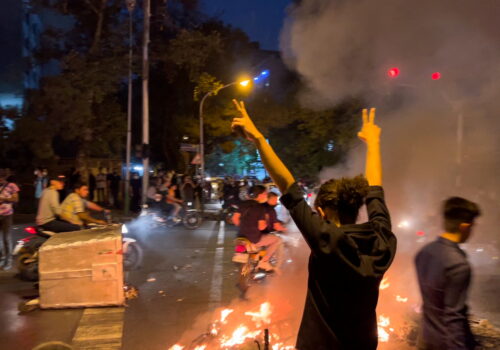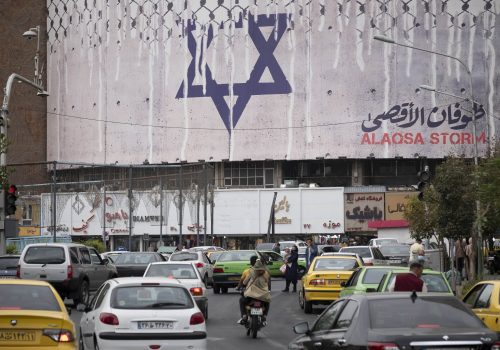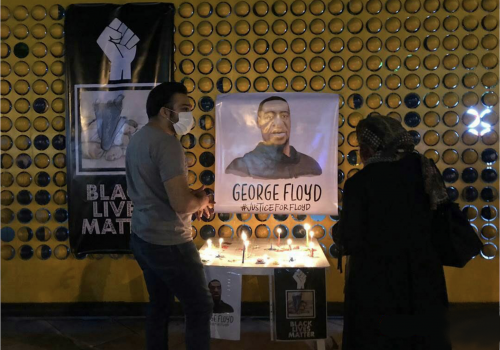The Islamic Republic claims to support US student protests, but it crushed its own student uprising
When pro-Palestinian student protests on US campuses led to instances of disciplinary action and police violence, one thing was immediately predictable: the repressive Islamic Republic of Iran will use this news to make two claims. First, it will argue that the United States and other liberal democracies are hypocrites who don’t really support human rights or freedom of expression. Second, it will claim that the protests vindicate Tehran’s position and even show its influence in the West. In the past few weeks, Iranian officials and state media outlets have indeed spread both messages.
On April 24, Supreme Leader Ayatollah Ali Khamenei’s X (formerly Twitter) English-language page already opined, “They say, ‘Why are you supporting Palestine?’ Today, the entire world is supporting Palestine. People are supporting Palestine in the streets of Europe, in Washington, and in New York.” In a speech on Teachers’ Day, Khamenei said the US attack on “non-violent and non-destructive” student protests “shows that the US is an accomplice to the Zionists.”
With a well-known knack for making comical claims, Iranian authorities went on to declare that suspended students in the United States could come to Iran and study on government-sponsored scholarships. “Iran’s universities are in a good place in international rankings and expelled American students in any field could come and use them,” a deputy science minister said.
SIGN UP FOR THIS WEEK IN THE MIDEAST NEWSLETTER
An editorial in Javan, a mouthpiece for the Islamic Revolutionary Guards Corps (IRGC), opined that the protests showed that “the American democracy is only a lie.” The editorial went on to claim that the US police response to the protests has been much worse than the Iranian police response to the 1999 pro-democracy student uprising—without mentioning the fact that at least seven students were killed by security forces there.
Iranic TV, an outlet tasked with monitoring Western outlets and producing clips that can be used for propaganda purposes, highlights alleged differences in how US media covers student protests in the United States and those in Iran.
The sheer volume of these productions is quite something. Dansehjoo, an outlet run by a student wing of the IRGC, has produced dozens of news reports and video clips on police actions at various US universities under the general label “the American Student Uprising” and with headlines such as “the violence of US military against students.” Telegram channels linked to the IRGC then help spread such clips widely.
Ironically, when opponents of student protests in the United States link them to Tehran, the regime tries to use that to its benefit. Thus, when Anti-Defamation League Chief Executive Officer (CEO) Jonathan Greenblatt claimed that some student groups were “campus proxies” of Tehran, his remarks were widely featured in Iranian state media.
Taking the argument further, another IRGC outlet claimed that the protests of today were taking place thanks to an open letter Khamenei published in 2015, addressing “the Youth in Europe and North America” following the Charlie Hebdo shootings in Paris.
But whatever claims the Iranian leadership makes, they are unlikely to be accepted by many Iranians who are well aware of the persistent repression meted out by the regime against students, women, and other Iranians. In fact, while Iranians disagree among themselves about the precise position to be taken in relation to the Israeli-Palestinian conflict, many seem to be united in ridiculing Tehran’s unlikely claims in favor of students.
Sadegh Zibakalam, a professor of political science at the University of Tehran, put a simple question to the “hardline outlets” that are writing about the US protests: “How many Iranian protesters have been killed and many how had their eyes hit by shot shells?”
The Islamic Republic’s behavior is especially jarring because the past few weeks have seen an uptick in repression. Units of the so-called morality police have an increased presence in Tehran and other cities, brutally arresting many women on accusations of improper veiling and closing down cafes where mandatory veiling rules are not observed.
Mostafa Faghiqi, a senior journalist who runs a centrist news outlet in Tehran, noted the closure of four such cafes in front of a university in Tehran and satirically wrote, “Now that these cafes are closed, the university management can comfortably focus on the illusion of getting protesting American students to come study here. For now, our own Iranian students can sit on the steps or on the ground in front of their university.”
To remind the regime of its brutality, many Iranians have been sharing images on social media of the brutal arrests of students during the 1999 movement. One of the major organizers of that attack was Baqer Qalibaf, then with the IRGC, who is now the speaker of parliament. Some users recounted how students were defenestrated out of their dormitories in an act of brutal violence. An X user said the fact that perpetrators of 1999 crimes would now speak of “worry for American students” was “the joke of the century.”
An Iranian feminist activist expressed her disbelief at the flag of Lebanon’s Iran-backed militia Hezbollah being used by a US student, remembering that in 1999 “our students were taken from their dormitories.” Another user recounted more recent crimes of the Islamic Republic toward students: blinding medical student Mohsen Jamali; imprisoning Said Madani, chair of the University of Tehran’s sociology department and Bahareh Hedayat, a leading student activist; and firing Ali Sharifi Zarchi, a professor at Tehran’s elite Sharif University who was critical of the regime.
Conversely, the regime’s hardline position against Israel and its backing of Palestinian terror groups seem to have little support among the Iranian people, least of all among youth and students. On May 6, when regime supporters tried to raise the Palestinian flag in a football stadium in northern Iran, fans responded with the vulgar chant: “Take that Palestinian flag and shove it up your a–.” A similar slogan was chanted during a game in October 2023, right after Hamas’s attacks on Israel. Even anti-regime activists who are pro-Palestinian have complained about how little activity there is in support of Palestine in Iranian universities. While there have been solidarity protests in support of US students in various countries around the world, such regime-staged efforts in Iran have produced meager results. Pictures published from such gatherings around Iran show that most consist of only a dozen people, some of whom appear to be university administrators rather than students.
The Islamic Republic will surely try to use the shocking images coming out of US universities to its benefit, but few Iranians will fall for its stale propaganda. No matter what the state-run hardline outlets publish or broadcast in Iran, Iranians remember the domestic repression they’ve seen with their own eyes—not just in 1999, but over the decades.
Arash Azizi is a writer and scholar. He is the author of The Shadow Commander: Soleimani, the US and Iran’s Global Ambitions and What Iranians Want. Follow him on X: @arash_tehran.
Further reading
Fri, Apr 12, 2024
Iranians sacrificed their lives to share videos of regime violence. Now there’s an online archive for the world to see.
IranSource By
The Iranian Archive holds more than one million videos to ensure that the Women, Life, Freedom uprising led by women would not be erased.
Fri, Oct 13, 2023
What do Iranians think of Israel? Their views might surprise you
IranSource By
Anyone familiar with Iranian society knows that anti-Israel attitudes have mostly failed to go beyond the most vociferous supporters of the regime despite years of attempted forced indoctrination.
Tue, Jun 23, 2020
Iranian officials’ hypocritical support of #BlackLivesMatter
Blog Post By
Over the past few weeks, Iranian officials have not shied away from condemning the killing of George Floyd, an unarmed African American man, by a police officer in Minneapolis, Minnesota on May 25.
Image: Pro-Palestine students stand in line, with a placard that says "From Iran to Palestine, Occupation is a crime" during the rally. Pro-Palestinian and Pro-Israel protesters at the University of Toronto outside student encampment occupying King College Circle. Advocating for Palestinian rights, students and faculty displayed banners depicting the plight of Palestinians, anti-Zionist and anti-Israel messages, while pro-Israel protests involved students and supporters in waving Israeli flags, and engaging in dialogues to defend Israel's actions and policies.


